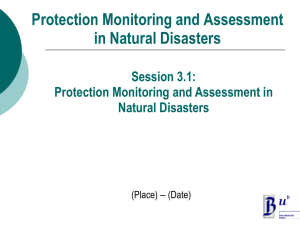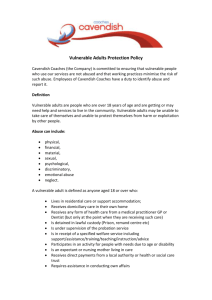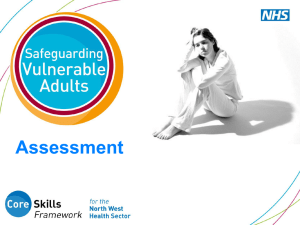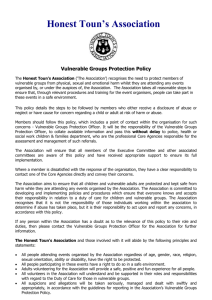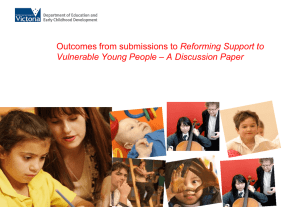Dorothy Scott - Fragile Families - Department of Education and Early
advertisement
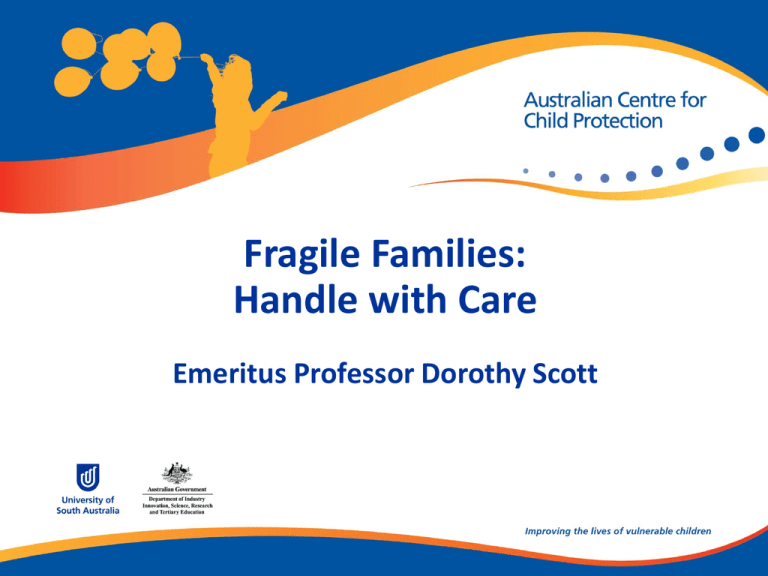
Fragile Families: Handle with Care Emeritus Professor Dorothy Scott Inquiries and...reform? The Protecting Victoria’s Vulnerable Children Inquiry (2012) is the most recent in a long line. Such inquiries do not necessarily lead to reform. Some do more harm, especially those with narrow terms of reference and undertaken in reaction to a highly politicised child protection tragedy. This Inquiry was not hindered by these factors. Time will tell whether it leads to action which will protect Victoria’s vulnerable children. The knowledge gap “Maltreatment is one of the biggest paediatric public-health challenges, yet any research activity is dwarfed by work on more established childhood ills.” The Lancet Editorial 2003, p. 443 Key Foci of Recommendations 1. 2. 3. 4. 5. 6. 7. Prevention Early Intervention Statutory child protection services Aboriginal children and young people The law and the courts Workforce Development System governance How might we take the first step? Prevention Child abuse and neglect cannot be solved solely by services. It requires population-based measures to tackle the key social determinants, including reducing risk factors such as parental alcohol misuse, and strengthening protective factors such as parent-child attachment and social support. Social marketing targeting harsh physical discipline, family violence and supervisory neglect is also worth trying and evaluating. Parental Alcohol Misuse • 13.2% of children in Australia live with at least one adult who regularly binge drinks (Dawe, 2006), and is the single largest contributing factor to children coming into out-of-home care. • Effective population based strategies include volumetric taxing, restricted advertising, licensing reform, and social marketing to change social norms Parent-Child Attachment • In utero – using ultrasound as an opportunity to individualise the foetus • avoiding threats to ante-natal attachment • Promotion of breastfeeding • Paid parental leave • Reducing separations in first year of life • Evidence-informed “clinical” interventions with vulnerable parent-infant dyads offered from universal service platforms Social Support • first time parent groups via maternal and child health and playgroups • tailored groups for young mothers, cultural/linguistic groups, women who have post-natal depression • facilitated playgroups • individualised befriending programs MCH related recommendations “The increased investment in MCH and Enhanced MCH should focus on: 1. Enhanced support to families whose unborn babies are assessed as vulnerable to abuse or neglect, especially as a result of pre-birth reports to child protection. 2. A more intensive program of outreach to families of vulnerable children who do not attend MCH checks, particularly in the first 12 months of life.” Why do we need reform? 1. The prevalence and long term effects of child abuse are so serious (The Lancet 2009 Special Issue). 2. Demand has outstripped the capacity of child protection systems to respond, placing the most vulnerable children in jeopardy. 3. The current “cure” of removing children is likely to be harming many children (Doyle, 2007; Rubin et al 2007). Australian prevalence estimates • Child physical abuse: 5-10% of adults • Penetrative child sexual abuse: 4-8% of males and 7-12% of females • Witnessing domestic violence: 12-23% (Price-Robertson, Bromfield & Vassallo, 2010) Long-term effects • Impairment of early brain development through neglect and witnessing violence • Higher incidence of adult health and mental health problems • Higher incidence of adolescent and adult substance misuse and offences • Greater risk of inter-generational child abuse and neglect Demand greatly outstrips capacity Based on current reporting rates, one in five Victorian children will be notified to statutory child protection services by the age of 18. A small minority of these are “substantiated”, and an even smaller proportion proceed to statutory intervention. No child protection system can cope with such demand pressures. It increases the likelihood that children at greatest risk will receive inadequate assessment and protection. Removal carries long-term risks A data linkage study of 45,000 Illinois child protection cases compared children at similar risk level where some were placed in foster care and others remained at home. School aged children on the margin of placement who remained at home had lower adult arrest rates, lower teen pregnancy rates and better employment than those placed in foster care. Doyle, National Bureau of Economic Research, 2007 Parental characteristics of children in out-of-home care, 2007 Parental substance abuse Domestic Violence Parental mental health problems 69.4% 65.2% 62.6% Delfabbro, Kettler, McCormick & Fernandez (2012), The nature and predictors of reunification in Australian out-of-home care, AIFS Conference, Melbourne. Single input services for families with multiple and complex needs??? We have a service system largely organised around single input services based on categorical funding. Families with multiple and complex needs often end up involved with a large number of organisations and in a revolving door of referrals and fragmented care. Engagement of parents remains a major challenge, and relationship-based practice is greatly diminished. The challenge… “The challenge of ending child abuse is the challenge of breaking the link between adults’ problems and children’s pain.” (UNICEF, A League Table of Child Maltreatment Deaths in Rich Nations, 2008) A wider role for adult services “The Government should enhance its capacity to identify and respond to vulnerable children and young people by providing funding to support specialist adult services to develop family-sensitive practices, commencing with an audit of practices of adult specialist services that identify and respond to the needs of any children of parents being treated, prioritising drug and alcohol services.” Recommendation 15. Cummins,P.,Scott, D. & Scales, B. (2012) Report of the Protecting Victoria’s Vulnerable Children Inquiry And MCH services? Have we enabled our MCH workforce to acquire the necessary competencies in parenting in the context of alcohol and other drugs, mental health, family violence and intellectual disability? Overall, I would say that MCH has made great gains in relation to parental mental health and family violence, but less so in relation to alcohol and other drugs and intellectual disability. What about collaboration? If we were to do an audit of the way in which services work together to address the adult problems linked to children’s pain, what might we find? While MCH is now much better linked with a range of child and family services, there is a long way to go generally in children’s services and adult specialist services working effectively together. Targeted Prevention and Intervention for Vulnerable Families Universal Prevention for all Children/Families Families at risk of violence Disability Mental Health IServices Children in need of placement Correctional services Homelessness services Child Protection Intervention Drug and alcohol services Moving from “it’s not my concern” to “it’s part and parcel of my job” 1. ‘core role only’ (‘it’s not my concern’) 2. ‘core role plus assessment of ‘other needs’, leading to referral’ (‘it’s a concern but someone else’s job – refer on’) 3. ‘other needs incidental but unavoidable’ (‘not my core role but I have to do it’) 4. ‘other needs’ intrinsic part of core role (‘it’s part and parcel of my job’) Three levels of service reform Service Providers Organisational Setting Policy Context The triangle of values, knowledge and skills Values for working with vulnerable families: ERGO Empathy Respect Genuineness Optimism What we know about ‘the therapeutic relationship’ Client factors and environmental factors (eg. social support) 30% Qualities of the therapeutic relationship 40% 15% 15% Hope and expectancy of positive outcome Specific intervention of technique From The Handbook of Psychology Integration by M.J. Lambert, 1992, P97. Relationship-based Practice In relationship-based practice with vulnerable families, we are the instrument of our own work. How do we care for and fine tune this instrument so we are able to convey the empathy, respect, genuineness and optimism required? How do we share our practice wisdom? What sustains us in our work with families? …a vocation which sustains us in working with vulnerable families References Dawe, S. et al (2006) Drug Use in the Family: impacts and implications for children. Australian National Council on Drugs Delfabbro, P., Kettler, L. McCormick, & Fernandez, E. (2012), The nature and predictors of reunification in Australian out-of-home care, AIFS Conference, Melbourne. Doyle, (2007) “Child Protection and Child Outcomes: Measuring the Effects of Foster Care” American Economic Review, 97(5). December : 1583-1610. Rubin, D., O’Reilly, A., Luan, X., & Localio, R. (2007) The impact of placement instability on behavioral wellbeing for children in foster care, Pediatrics, 119: 336-344. O’Donnell, M., Scott, D. & Stanley, F. (2008) Child abuse and neglect – is it time for a public health approach? Aust & NZ Journal of Public Health, 32,4,325-330 Price-Robertson, R., Bromfield ,L.& Vassallo , S. (2010) What is the prevalence of child abuse and neglect in Australia? A review of the evidence. AIFS conference, Melbourne. www.aifs.gov.au Scott, D, (1992) Reaching vulnerable populations: framework for primary service provision, American Journal of Orthopsychiatry, 62,332-341 Scott, D. (2009) Think Child, Think Family, Family Matters, 81:37-42. Emeritus Professor Dorothy Scott Australian Centre for Child Protection University of South Australia dorothy.scott@unisa.edu.au www.unisa.edu.au/childprotection

